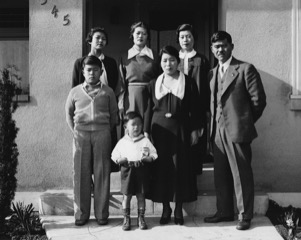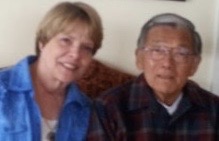Historical museums often expose people to previously unknown segments of history. Andrea Warren’s understanding of Japanese American internment camps was forever changed after visiting the interpretative center for the former Heart Mountain Relocation Center. Warren’s tour opened the door to years of researching Enemy Child: The Story of Norman Mineta, a Boy Imprisoned in a Japanese American Internment Camp During World War II.
Children learn to appreciate history when they are able to connect with key personalities. In Enemy Child, Andrea Warren takes middle school readers back in time to the bombing of Pearl Harbor in 1941. Through the eyes of Norman Mineta, an American born child with Japanese born parents, readers see the obstacles that he and his family faced during the war years. Mineta’s recollections highlight only one of the 120,000 Japanese Americans living on the West Coast who were forced to relocate to one of the 10 internment camps in California, Idaho, Wyoming, Utah, Colorado or Arkansas. Warren weaves Mineta’s personal accounts together with pertinent facts about life in America during World War II.

By looking at informative black and white photos, diagrams, posters, signs, and political cartoons, young readers can visualize the travails of the family as well as the politically charged environment that made the public fearful of anyone who looked Asian. In many places, discrimination became a new way of life for people with Asian ancestry. Mineta struggled. “..since I looked like the enemy, I thought I must be the enemy—because they sure thought I was.” (Page 27)
After President Roosevelt signed Executive Order 9066, the United States government moved Japanese Americans away from the Pacific Ocean coastline. Mineta and his family found themselves at the Heart Mountain War Relocation Center. In just two months, this rural part of Wyoming witnessed the construction of housing for 10,000 people. Warren takes readers into the world of a child trying to cope with an environment that made him feel subhuman. Instead of enjoying his parent’s California home, Mineta lived in a single room with his family and used a communal bathroom a half block away from his tiny residence. He attended school, played with friends, experienced snow for the first time, hiked up Heart Mountain, and joined Boy Scout Troop 379.
Minelta’s troop met a local troop where he had the opportunity to spend the day with Alan Simpson, who, like Mineta was eleven years old. After hanging out with Mineta, Simpson went home with a different impression of Japanese Americans. “I learned from Norman Mineta that we were both Americans and we were the same on the inside. We just looked different on the outside.” (Page 121)
To avoid becoming depressed, Mineta’s family maintained a positive attitude. They insisted on staying neat and clean throughout their confinement. They also adhered to a Zen philosophy, “if you can’t change it, you accept it and make the best of it.” (Page 95) That underlying belief fueled their desire to remain loyal to America throughout their ordeal.
Mineta grew up quickly in the camp. After his older siblings moved outside the camp and his father relocated to Chicago to teach Japanese to enlisted men in the Army Specialized Training Program, Mineta took care of his mother until they were allowed to travel. In Chicago, their freedom was restored when they moved into a small bungalow. After the war, the family returned to California where compassionate people had kept their possessions safe.
Children who overcome obstacles in their youth sometime become adult role models. Warren uses the concluding chapters to provide an overview of Mineta’s adult years, including his notable political career—city councilman, first elected Asian mayor of a major American city, US Congressman for ten terms, Secretary of Commerce under President Clinton, and Secretary of Transportation under George W Bush. After listening to Mineta and others, the U.S government acknowledged the injustices done to Japanese Americans. President Ronald Reagan passed the Civil Liberties Act of 1988. Mineta received the American Presidential Medal of Freedom and the Japanese GrandCordon, Order of the Rising Sun for his exceptional public service. Today, people flying in and out of San Jose recall his legacy when they enter Norman Y. Mineta San Jose International Airport.

Some may wonder why little is know about this chapter of American history. Mineta states that there was a conspiracy of silence. “In Japanese culture you don’t discuss bad things. You don’t share your feelings.” (Page 160)Mineta as well as others knew that it was a topic that few Japanese Americans wanted to talk about. By convincing Mineta to tell his story and be profiled in Enemy Child, Warren opens the door for young people to explore this controversial period of American history.
Stay tuned… for an interview with Andrea Warren.
Book Awards
- A California Reading Association Eureka! Nonfiction Gold Award Winner
- Winner of the Society of Midland Authors Award’s Children’s Reading Round Table
- Award for Children’s Nonfiction A Capitol Choices Noteworthy Title
- A Junior Library Guild Selection
- A School Library Journal Best Book of the Year
- A Bank Street Best Book of the Year – Outstanding Merit
-
The American Society of Journalists & Authors Outstanding Children’s/Young Adult Book Award 2020
-
The Society of Midland Authors 2020 Children’s Reading Roundtable Children’s Nonfiction Award
-
Arizona’s Grand Canyon Reader Award nominee for 2021
DISCLOSURE
I received a complimentary copy of Enemy Child: The Story of Norman Mineta, a Boy Imprisoned in a Japanese American Internment Camp During World War II.
BIO
Sandra Bornstein is the author of May This Be the Best Year of Your Life. Sandra’s memoir highlights her living and teaching adventure in Bangalore, India. She was a licensed Colorado teacher who taught K-12 students in the United States and abroad. Sandra also taught college-level courses at Front Range Community College and the University of Colorado-Boulder.
In addition to reviewing books and interviewing authors, Sandra is an award-winning author and lifestyle and travel journalist. Many of Sandra’s travel stories appear on the For Readers Page. TheTravelingBornsteins website showcases recent travel and lifestyle stories.

Connect with Sandra